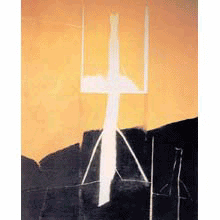 |
Vladimir Novak By the end of the 1970s and beginning of the '80s, Vladimir Novak had already found the basis of his individual artisticlanguage. The multifigurative composition produced at the beginning of his career, which taught him to master the space of the picture, were soon superseded. In the second half of the 1970s, Novak had worked towards a strongly ascetic simplification of means used to build up the picture, being more interested in mastering the composition and revealing relationships between man and space, the individual and the world. In order for the nature of this relationship to manifest itself most clearly, Novak reduced his artistic menas to a form of drawing which narrated the situation in grey, brown and black tones. He also worked towards disrupting the traditional, fixed form of the picture, an element of which was created at the time by fragments of figures painted on stiff card or harboard which emerged from space and traced the forms of the painting's drawing. Elsewhere, Novak cut out whole parts of the pictorial area, revealing the blind frame of the painting and the space behind it. The overall impression of the completedpicture suggested a conviction about the imposibility of a definitive conclusion. The traditionl wall-hung painting was in this way explored anew from its very basis; the form in which it had thus far existed and the possibility of its further existence was cast in doubt, and at the same time Novak proved the unexpected possibilities of its capacity to bear meaning and messages. Vladimir Novak's latest work is oriented towards an equilibrium between expressiveness and inner qualities, between sensuality and intellect. Once and again, in an ever free way, he is concious not only of his own inner disposition, his bonds with place and time, but also his deeply-rooted place in the European artistic tradition reaching far back before the birth of modern art. |
|